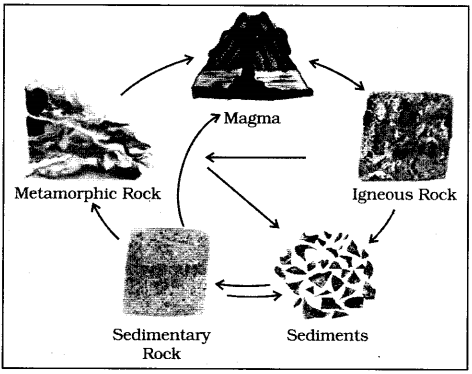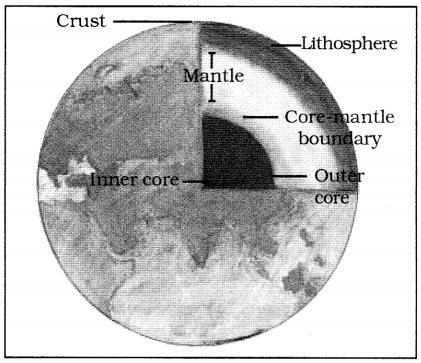Inside Our Earth Class 7 Geography Chapter 2 Extra Questions and Answers Social Science CBSE Pdf free download are part of Extra Questions for Class 7 Social Science. Here we have given NCERT Extra Questions for Class 7 Social Science SST Geography Chapter 2 Inside Our Earth.
You can also practice NCERT Solutions for Class 7 Geography Chapter 2 Questions and Answers on LearnInsta.com.
Class 7 Geography Chapter 2 Extra Questions and Answers Inside Our Earth
Inside Our Earth Class 7 Extra Questions and Answer Geography Chapter 2 Very Short Answers Type
Question 1.
Why is the earth called a dynamic planet?
Answer:
The earth is called a dynamic planet because movements, forces etc., constantly act inside and outside the earth.
Question 2.
Name the uppermost layer of earth.
Answer:
The uppermost layer of earth is called crust.
Inside Our Earth Class 7 Extra Questions and Answer Geography Chapter 2 Short Answers Type
Question 1.
Into how many types the layers of the earth is divided?
Answer:
The earth consists of three layers:
- Core (inner core and outer core)
- Mantle (upper and lower mantle)
- Crust (continental and oceanic crust)
Question 2.
What do you understand about uppermost layer of the earth? Briefly describe.
Answer:
The uppermost layer over the earth’s surface is called the crust. It is the thinnest layer and its depth is about 40km, and its range is about 35km on the continental masses and only 5 km, on the ocean floors.
Question 3.
How is a sedimentary rock made?
Answer:
Rocks roll down, crack, and hit each other and are broken down into small fragments. These smaller particles are called sediments. These sediments form sedimentary rocks.
Question 4.
What are extrusive igneous rocks? Give an example.
Answer:
When the molten lava comes on the earth’s surface, it rapidly cools down and becomes solid. Rocks formed in such a way on the crust are called extrusive igneous rocks. They have a very fine-grained structure. The Deccan plateau is the example that is made up of basalt rocks.
Question 5.
What are intrusive igneous rocks? Give an example.
Answer:
Sometimes the molten magma cools down deep inside the earth’s crust. Solid rocks so formed are called intrusive igneous rocks. Since they cool down slowly they form large grains. Granite is an example of such a rock. For grinding of spices and grains, the stones used are of granite.
Inside Our Earth Class 7 Extra Questions and Answer Geography Chapter 2 Long Answers Type
Question 1.
Describe the Rock cycle.
Answer:
In a cyclic manner one type of rock changes into another type. As we already learnt when the molten magma cools, it solidifies to become igneous rock. These igneous rocks are broken down into small particles that are transported and deposited to form sedimentary rocks.
When the igneous and sedimentary rocks are subjected to heat and pressure they change into metamorphic rocks. The metamorphic rocks which are under great heat and pressure melt down and form molten magma. This molten magma again can cool down and solidify into igneous rocks.
The Rock cycle can be understood and expressed by cycle as shown below:

Question 2.
Describe various types of rocks.
Answer:
Rocks are of three types, which can be described as under:
(i) Igneous rocks: When the molten magma cools, it becomes solid. Rocks thus formed are called igneous rocks. They are also called primary rocks. Igneous rocks further can be divided into two types- intrusive and extrusive rocks.
(a) Intrusive igneous rocks: Sometimes the molten magma cools down deep inside the earth’s crust. Solid rocks so formed are called intrusive igneous rocks.
(b) Extrusive igneous rocks: When molten lava comes on the earth’s surface, it rapidly cools down and becomes solid. Rocks formed in such a way on the crust are called extrusive igneous rocks.
(ii) Sedimentary rocks: When rocks roll down, crack, and hit each other and are broken down into small fragments, these smaller particles are called sediments. These sediments are transported and deposited by wind, water etc. These loose sediments are compressed and hardened to form layers of rocks. These types of rocks are called sedimentary rocks.
(iii) Metamorphic rocks: Igneous and sedimentary rocks can change into metamorphic rocks under great heat and pressure. For example, clay changes into slate and limestone into marble.
Picture Based Questions Class 7 Geography Chapter 2 Inside Our Earth
Question 1.
Draw a structure of the interior of the earth
Answer:
